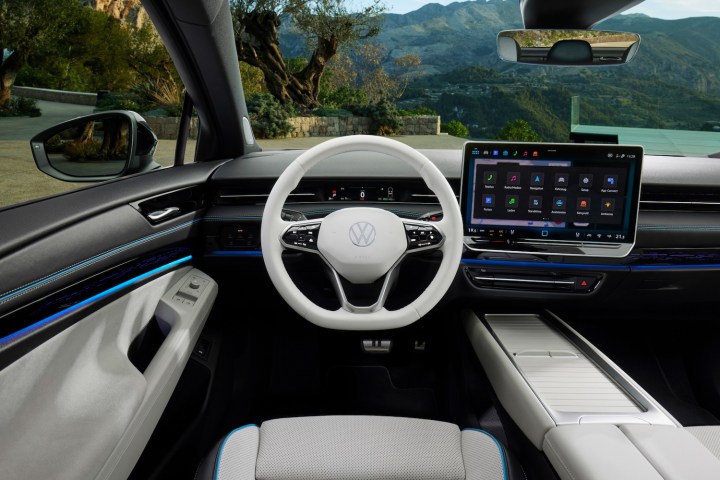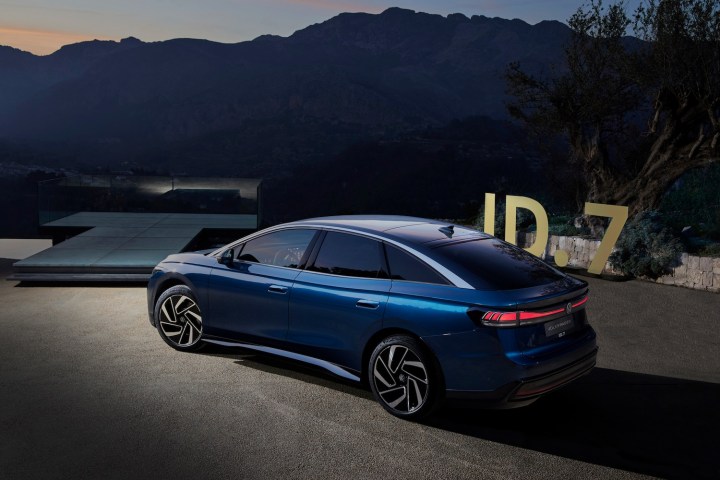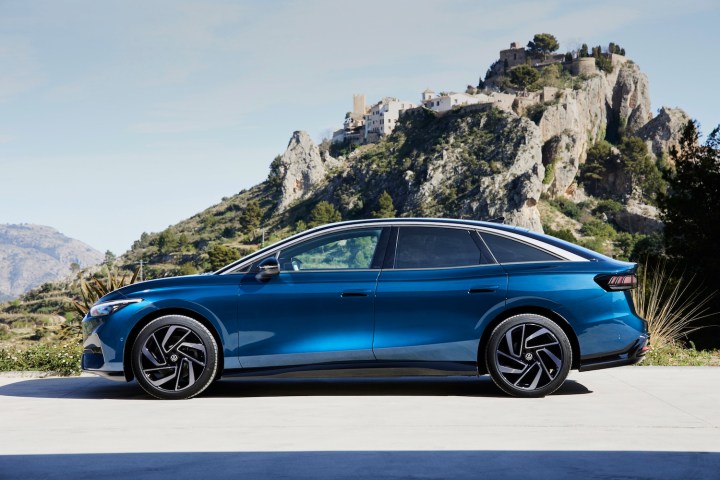Volkswagen wants its electric cars to go head-to-head with gasoline models, but only now is it replacing one of those models with an EV.
While, the VW ID.4 is pitched as an electric alternative to popular gasoline crossover SUVs, and the ID.Buzz taps a well of nostalgia, the Volkswagen ID.7 fills a gap in the lineup left by the Passat, which ended production with the 2022 model year after nearly 50 years as VW’s staple sedan in the United States.
Scheduled to go on sale in the U.S. in 2024, and previously teased at CES 2023, the ID.7 aims to breathe new life into the sedan segment with electric power, more tech, and aerodynamic styling reminiscent of the other ID models. Yet while it’s a recommitment to sedans for VW, the ID.7 doesn’t have the market to itself. EV shoppers already have the Hyundai Ioniq 6, Polestar 2, and Tesla Model 3 to consider.
A sleeker shape
Stripping away the camouflage shows many styling features that are recognizable from other ID models, including slim headlights mounted high on a grille-less front fascia, rounded edges, and body sides with sectioned, sloping elements like beachside cliffs that have been subject to much erosion. As with the ID.4 and ID.Buzz, the goal was to reduce aerodynamic drag and create a look that’s distinctively EV.
The ID.7 is 1.7 inches longer than the Passat, with a 6.4-inch longer wheelbase that should benefit interior space. It’s also a bit wider and taller than the Passat, which was a midsize sedan roughly the same size as well-known models like the Honda Accord and Toyota Camry. The ID.7 also has the fastback shape of the VW Arteon, positioned as a more luxurious model than the old Passat, but is 2.1 inches longer.
These dimensions make the ID.7 the largest VW sedan (the only other such model in VW’s U.S. lineup is the compact Jetta) but put it close to other electric sedans. It’s longer than the Hyundai Ioniq 6, Polestar 2, and Tesla Model 3, but the Hyundai’s wheelbase is nearly the same. The VW is about as wide as these other models, but it’s the tallest of the group, standing about four inches taller than the Tesla.
Glass cockpit
The ID.7 gets a freestanding 15-inch touchscreen that handles most functions, including climate control and seat adjustments. VW also kept touch sliders for audio volume and cabin temperature, one of the more controversial features of the previous ID models. If those prove too frustrating, voice control is included as well.
The driver interface is a bit different, though. The ID.7 gets a more elaborate head-up display with augmented-reality functions that VW claims will allow drivers to rely less on the instrument cluster, which will still show basic information like speed. The head-up display will be able to show that as well, though, plus the posted speed limit, and navigation directions. This information will be shown in the driver’s field of vision at different distances, with navigation information placed further out so it looks like it’s being projected onto the landscape.
Driver aids include an updated version of VW’s Travel Assist system with an automated lane-change function, keeping up with systems like Hyundai’s Highway Driving Assist and Nissan’s ProPilot Assist, but without the greater functionality of General Motors’ Super Cruise. Automated parking — already offered by Hyundai and Tesla — will also be available.
More power, greater efficiency
At launch, the ID.7 will be available in Pro spec with an 82-kilowatt-hour battery pack but will be followed up by a Pro S model with a 91-kWh pack. U.S. range estimates aren’t available yet, but VW estimates 382 miles with the smaller pack and 435 miles with the larger pack on the European WLTP testing cycle. Equivalent U.S. figures will be lower, but it’s possible that at least some versions of the ID.7 will exceed 300 miles.
The ID.7 also debuts a new motor VW claims is more efficient than the ones used in existing electric models like the ID.4 and ID.Buzz. It also produces 282 horsepower — a big upgrade from the 201 hp rating for single-motor versions of those models. A dual-motor all-wheel drive powertrain like the one currently offered in the ID.4 will likely arrive after the single-motor version.
VW says the ID.7 can DC fast charge at 170 kilowatts with the smaller battery pack and 200 kW with the larger pack. Battery preconditioning, which automatically optimizes temperature before charging, should help the ID.7 hit those maximum power rates as often as possible.
Choice matters
With the ID.7’s U.S. launch so far out, it’s a bit too early to talk pricing. With the ID.4 already established as the entry-level model in VW’s EV lineup, though, it’s possible the ID.7 won’t be the cheapest EV around. That would also be in line with the Hyundai Ioniq 6, which has a relatively low base price, but ends up in the more premium territory of the Polestar 2 and Tesla Model 3 once options are added.
Just offering an electric sedan proves VW is serious about its mission to make EVs with mass appeal. Given the current popularity (and profitability) of SUVs, it made sense to make the ID.4 the first of VW’s new EVs out of the gate. But variety is a big part of the appeal of cars, and it would be a mistake to launch only SUVs, assuming that’s what everyone wants. EV buyers shouldn’t be forced to buy SUVs. The ID.7 is looking like a nice alternative.
Editors' Recommendations
- Here’s how EVs charge as they drive on a stretch of Michigan road
- The Maserati GranCabrio Folgore is one of the best-looking EVs yet
- Genesis Neolun concept is an electric SUV inspired by tradition
- Tesla faces new rival as a tech giant launches its first EV
- Porsche’s most powerful production car is an EV






